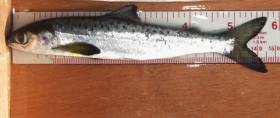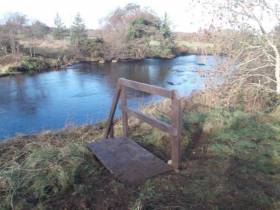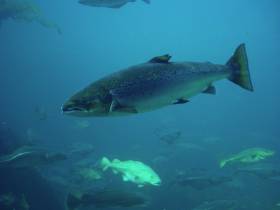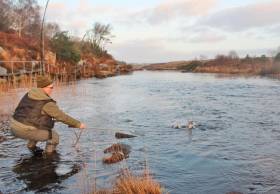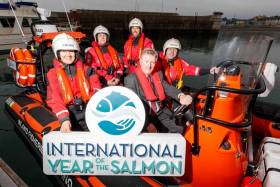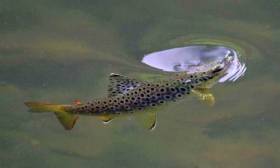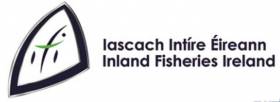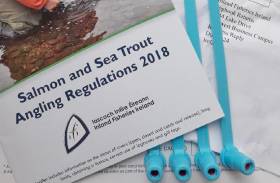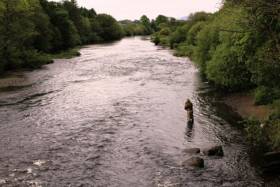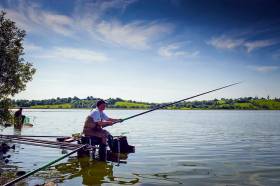Displaying items by tag: Salmon
Young Salmon Survival is 'Surprisingly Low' When Migrating to Sea - Report
A new study shows low salmon survival leaving freshwater is an important factor in declining European salmon populations, according to early results from a project examining the early migration phase of salmon smolts (young salmon) from rivers across Europe. Leading salmon scientists from Denmark, Spain, Sweden, UK and Ireland are today attending an important meeting in Dublin, hosted by Inland Fisheries Ireland, to mark International Year of the Salmon. The scientists will discuss some of their new findings from the international SMOLTRACK project, the results of which reveal factors in the known decline of salmon stocks.
The SMOLTRACK Project, which is funded by the North Atlantic Salmon Conservation Organisation (NASCO) / EU, aims to help determine the survival rates of young salmon as they move from rivers into the marine environment. Work commenced in 2017 and early results show that survival during movement from rivers to the sea is lower than expected. While it was already accepted that salmon are impacted by a number of factors when they migrate at sea including the effects of climate change, limited feeding opportunities and sea lice-induced by fish farms, the low survival rate in river systems which is presenting in this research is a new development.
The low survival of smolts in some river systems could be attributed to changes in temperature and flow while predators have also been shown to impact on the numbers entering the sea. The survival of smolts varies by catchment and in a bad year, survival of smolts can be three times lower than in a good year. These results will be published in international journals on completion of the research.
The international project sees scientists from each participating country tag salmon smolts with miniaturised acoustic and radio transmitter tags in rivers in their own country, and track their migration journey through the lower parts of rivers, estuaries and coastal areas. This study includes populations in Southern Europe which are most vulnerable to climate change. In Ireland, this work is being carried out in the River Erriff, Inland Fisheries Ireland’s National Salmonid Index Catchment (NSIC).
In addition to the activity in Ireland, tagging is being carried out on the River Bush (Northern Ireland), River Tamar (England), River Ulla and River Minho (Spain), River Göta and River Högvadsån (Sweden), River Skjern and River Storaa (Denmark). This information will help scientists to understand the survival rates of salmon smolts during their migrations under varying conditions ranging from cooler climates in Sweden to warmer climate in Spain. Already SMOLTRACK is providing new data on the initial migration of salmon smolts which will inform future management and conservation measures for this iconic species.
Dr William Roche, Senior Research Officer at Inland Fisheries Ireland said: “Understanding and comparing early marine survival of salmon in EU waters is a key output of this project in addition to providing data on smolt run timing and migration behaviour. The project has established a European-wide counting, tagging and tracking system to monitor smolts and will also contribute to understanding of the possible impacts of climate change.”
Dr Cathal Gallagher, Head of Research and Development at Inland Fisheries Ireland said: “We have seen a substantial reduction in the numbers of salmon returning to Irish shores in recent decades. This project is examining what is happening to our young salmon as they migrate to sea and what the international community needs to do to help salmon populations. While this research identifies issues in early mortality of salmon, this part of a salmon’s life cycle is where management actions can be targeted to support the future of these salmon stocks. International Year of the Salmon offers an opportunity to share knowledge across the Northern Hemisphere with a view to inspiring action and collaboration with a positive effect on salmon survival.”
International Year of the Salmon is a joint worldwide initiative of the North Atlantic Salmon Conservation Organisation (NASCO) and the North Pacific Anadromous Fish Commission (NPAFC) alongside other partners across the globe, creating an international framework for collaborative outreach and research. It is hoped that IYS will raise awareness of what humans can do to ensure salmon and their habitats are conserved and restored against a backdrop of several environmental factors.
For more information about the SMOLTRACK project, visit here
New Project To Improve Angling Access On River Easkey
#Angling - A new project on the River Easkey in Co Sligo which has improved and developed angling access to the wild salmon river between Sligo and Ballina has now been completed.
The project, which was delivered by River Easkey Angling Association, received support from Inland Fisheries Ireland (IFI) via the National Strategy for Angling Development.
Structures such as footbridges, stiles, and ladders were installed along the river, which is located on the Wild Atlantic Way, while walkway routes on the banks of the salmon and trout fishery were also improved.
The work took place upstream of the famous Workhouse Bridge as part of the second phase of this project which initially involved similar works downstream of the bridge last year.
In total, the project has delivered eight new access points to angling, 13 footbridges ranging from three to four metres in length, and five kilometres of improved trail access.
Sean Canney, Minister of State for responsibility for inland fisheries, said on Wednesday (23 January): “I welcome the continuing efforts of Inland Fisheries Ireland in delivering under the National Strategy for Angling Development in partnership and collaboration with local angling clubs and community groups nationwide.
“Inland Fisheries Ireland committed €23,500 in total to support the Easkey project with €10,000 awarded in 2017 and a further €13,500 granted in 2018.
“I also want to congratulate the River Easkey Angling Association on its excellent development ethos. They are a progressive group that helpfully operates an open policy for holders of a State Salmon License with season and day tickets available for access,” he added.
Suzanne Campion, head of business development at IFI, said: “The River Easkey Angling Association has done fantastic work in developing this area as an angling destination. While completing this project and working closely with our project officers, they have given due diligence to everything from financial and environmental governance to biosecurity considerations ensuring the conservation and protection of this wonderful resource.”
Alan Spencer, assistant secretary of the River Easkey Angling Association, expressed the club’s thanks to Inland Fisheries Ireland’s staff for all their help and support during the project, as well as gratitude to landowners who permitted the club and its contractor access to the river through their property.
To track Atlantic salmon movements from river to sea and back, millions of salmon have been tagged over the past 50 years as part of scientific international tagging programmes.
Recently, ICES published a co-operative research report documenting 50 years of marine tag recoveries from Atlantic salmon, and marking 2019’s declaration as International Year the Salmon.
Programmes have included tagging of smolts, migrating out from their freshwater nurseries to the sea and their recaptures in high-seas fisheries off Norway and the Faroes, in coastal fisheries around Greenland and upon return to home waters.
Other studies included tagging of adults caught at sea and their subsequent recaptures in home waters in coastal fisheries and by anglers.
“Tagging and related data efforts are crucial as scientists seek to improve understanding of wild Atlantic salmon distribution and migration at sea and the underlying causes of mortality,” said Niall O'Maoileidigh of the Marine Institute.
“This is particularly important given that, despite initiatives that have mitigated some declines, abundance of the species has continued to drop in the last two decades.”
Tagging has included various types of external ‘floy tags’ focusing in the past 20 years on coded wire tags, less than 2mm in length and delicately implanted into the nose cartilage of fish.
This report not only documents the history of these tagging programmes for posterity but also investigates migration patterns, timings, return rates, their changes and patterns.
“Mass marking techniques still provide basic information on survival rates, exploitation rates and migration in general. However, with current technology e-tagging is becoming far more informative, giving rise to information not only of the ‘when and where’ of tagging-releases and recaptures, but also on the movements, routes, depths and behaviours in-between,” O’Maoileidigh added.
Earlier this week Ireland’s first salmon of 2019 was caught and released on New Year’s Day in Co Donegal.
#Angling - Only hours after 84 Irish rivers were opened to salmon angling on Tuesday 1 January, the first salmon of 2019 was caught and released on the Lackagh River in Co Donegal.
Michael McCann of Templeard, Derry landed the 5lb fish in the Garden Pool on the Lackagh River at 9.25am yesterday using a single barbless hook, before it was released back into the water.
The fish was also the first salmon caught and released during International Year of the Salmon which takes place throughout 2019.
McCann was one of 22 anglers who were fishing on the Lackagh at the time of the catch. The river is not known for producing the first salmon of the angling season — in 2018, the first was recorded on the River Drowes in Leitrim on 30 January while in 2017 it was caught on the Munster Blackwater in Cork on 1 February.
Congratulating McCann on his catch, Dr Ciaran Byrne, CEO of Inland Fisheries Ireland, said: “We are particularly delighted that the first salmon of 2019 was caught and released in a sustainable manner in Donegal in compliance with the 2019 regulations.
“I would urge anglers to step up their conservation efforts and engage in catch and release angling in 2019. The new year coincides with International Year of the Salmon which aims to raise awareness of some of the challenges facing salmon stocks across the Northern hemisphere.
“Salmon populations have plummeted in recent years with the number of salmon returning to Irish shores decreasing by over 70%, which is very concerning.
“We look forward to promoting this global initiative in Ireland which aims to bring people together to share knowledge, raise awareness and take action on how we can ensure the resilience of salmon in Ireland and across the Northern hemisphere.”
The Lackagh River is open to catch and release fishing during the 2019 season. The regulations for the management of the wild salmon and sea trout fishery for 2019 including the list of open, catch and release and closed rivers can be found on the IFI website.
It is estimated that 240,000 Atlantic salmon returned to Irish shores last year, according to Inland Fisheries Ireland. The enduring Atlantic salmon populations in Irish waters were being highlighted at the launch of the International Year of the Salmon (IYS), which takes place in 2019. Sean Canney TD, Minister with responsibility for the inland fisheries sector, marked the launch by unveiling one of a new fleet of 12 RIBs (Rigid Inflatable Boats) to highlight the importance of fisheries protection especially during migration along the coasts.
Atlantic salmon populations are widely distributed throughout Irish freshwaters with over 140 such systems designated as salmon rivers. While 240,000 Atlantic salmon returned to Ireland from the sea as part of the natural migration last year, representing the healthy condition of Irish river stocks, the numbers returning to Irish shores has decreased by over 70 per cent in recent decades. In the 1970s, the number of Atlantic salmon returning peaked at 1,800,000.
Minister Canney said: “It is vital that we protect our valuable fisheries resource as environmental change and human impacts are placing salmon and other species at risk. The International Year of the Salmon is a global initiative which aims to bring people together to share knowledge, raise awareness and take action on how we can ensure the resilience of salmon in Ireland and in the Northern Hemisphere. Ireland is recognised as an international exemplar in terms of placing the conservation imperative at the very heart of our salmon management and I am committed to leading our participation in this initiative on behalf of the Government, the Department and Inland fisheries Ireland”, he added
The continuing declining trend in many wild salmon stocks both nationally and internationally in recent decades has been attributed to many different factors such as climate change, alterations to physical habitats, water quality issues, predation, over-fishing and increased mortality due to sea lice.
International Year of the Salmon is a joint world-wide initiative of the North Atlantic Salmon Conservation Organisation (NASCO) and the North Pacific Anadromous Fish Commission (NPAFC) alongside other partners across the globe, creating an international framework for collaborative outreach and research. It is hoped that IYS will raise awareness of what humans can do to ensure salmon and their habitats are conserved and restored against a backdrop of several environmental factors.
Dr Ciaran Byrne, CEO of Inland Fisheries Ireland said: “I am delighted that we are adding to our protection fleet today, particularly in light of the challenges facing salmon stocks across the Northern hemisphere. In Ireland, salmon are part of our national identity, holding a special place in our culture and heritage. In fact, salmon populations have sustained many rural communities over many decades. The extraordinary life cycles of salmon however exposes them to many environmental and human caused factors which influence their health and populations.
Fisheries managers and scientists have been concerned for a number of years about the declining numbers of salmon returning to the Irish coast. International Year of the Salmon offers us an opportunity to start an important conversation around how we can protect, conserve and restore salmon populations in Irish and international waters and more importantly, how we can inspire action. Inland Fisheries Ireland looks forward to continuing this conversation over 2019 and beyond.”
Minister Canney emphasised that since 1996, a progressive series of conservation initiatives have been introduced in Ireland to try to address the decline in salmon stocks. Inland Fisheries Ireland implements the Wild Salmon Conservation Scheme, managing rivers on an individual basis, rather than a national or district basis with only rivers with an identifiable surplus over the conservation limit open for the harvest of salmon and sea trout. In addition, the Salmon Conservation Fund, which is generated from the sale of salmon angling and commercial fishing licences, reinvests in projects which promote the recovery of salmon stocks and habitats.
During International Year of the Salmon, Inland Fisheries Ireland will introduce a commemorative salmon licence which will include updated information for anglers on catch & release angling. Carcass tags will also be rebranded to read: ‘Do you need me? Think twice before killing.’
The new fisheries protection RIB, officially introduced to the protection fleet in Greystones, Co. Wicklow to mark the start of International Year of the Salmon, will serve the east coast and larger inland lakes in the Eastern River Basin District. It comes after the launch of other RIBs around the country in recent months. Inland Fisheries Ireland is replacing its sea going RIB fleet with 12 new DELTA 780HX Maritime Protection RIBs built by Delta in Manchester. This will ensure proper protection of salmon in the coastal waters of Ireland out to the 12 mile limit.
New Protections For Wild Brown Trout As Designated Salmonid Waters Bye-law Comes Into Operation
#Angling - The Designated Salmonid Waters Bye-law was yesterday (Thursday 25 October) signed by the Minister for Communications, Climate Action and Environment, Richard Bruton.
The overall intention behind the bye-law is to afford additional protection to wild brown trout in seven distinctive State–owned waters where established stock control measures are already in place as a matter of existing policy.
The seven waters are Lough Sheelin in the Limerick Fishery District; Loughs Conn and Cullin the Ballina Fishery District; Loughs Corrib, Mask and Carra in the Galway Fishery District; and Lough Arrow in the Sligo Fishery District.
Sean Canney, who is succeeding Sean Kyne as Minister of State with responsibility for the inland fisheries sector, welcomed the bye-law as an important initiative for brown trout fisheries particularly in the West of Ireland.
“My predecessor Seán Kyne gave notice of his proposals to make the bye-law and also instigated a public consultation during which observations and views expressed across the full range of stakeholders,” said Minister Canney.
“I am happy as incoming minister to support Minister Kyne’s long-standing initiative and his hard work over all of 2018 in bringing the bye-law to fruition.”
Minister Kyne said: “As minister with responsibility for inland fisheries, I had carefully considered the submissions made in the public consultation.
“The bye-law relates to seven limestone lakes which are quite unique in terms of topography and trout habitat and have long been managed as wild brown trout fisheries via established stock management programmes. From that perspective, I considered that these waters are especially important.
“The bye-law was just about complete when I was taking on my new role and I am grateful for the support of Ministers Bruton and Canney for bringing it over the line,” he added.
The bye-law gives statutory status to the policy designation of this small number of distinctive waters and means that the waters concerned will continue to be managed primarily as brown trout waters.
Minister Kyne had indicated his view that the importance of these waters should be reflected by way of statutory designation and commenced that process in the department.
The bye-law also includes the prohibition on the introduction of fish to the designated waters which is consistent with the overall policy thrust of Inland Fisheries Ireland to manage these waters primarily as brown trout waters.
The advantages of this measure include addressing biosecurity and genetic concerns, control and management of the potential transfer of pathogens, and safeguarding against the introduction of alien invasive fish species.
The announcement came as Bord Iascaigh Mhara is hosting a two-day conference on the scientific developments within the salmon farming industry in Galway’s Maldron Hotel on 25-26 of October.
Outlining the purpose of the event, BIM’s Geoffrey Robinson said: “With increasing global demand for fish, aquaculture is now the fastest-growing animal food production sector in the world. Consequently, fish farming operations are rapidly evolving with new technologies and equipment constantly being developed.
“Part of BIM’s work is to help fish farmers to keep their operations at the cutting edge of technology and an event like this allows us to showcase the latest innovations to Irish operators. There will be a number of interesting developments discussed not least the growing use of cleaner fish and desalination systems.”
Twenty-five separate presentations from national and international experts will cover the latest research and technological developments within the sector on issues such as fish health and welfare, structural and service equipment as well as organic certification.
“While production volumes in Ireland are small by international standards, we have a reputation for excellence in organic salmon production and it is important that our operations maintain this high standard. Incorporating leading edge technologies can improve our production efficiencies and strengthen our sustainable practices,” Mr Robinson added.
In 2017 Irish salmon production increased 15.6% to 19,305 tonnes, with a value of €141.2 million. The industry employs 210 people, primarily in production sites along the west coast of Ireland. Irish salmon is exported to diverse markets across the EU, North America and the Near and Far East.
No Salmon Licence Results in Large Fine & Driving Disqualification
On Tuesday 25th September 2018, Conor Harlowe with an address at 12 Shantalla Place, Rahoon Road, Galway was convicted at Tuam District Court for refusing to give his name and address contrary to Section 301 (7) of the Fisheries (Consolidation) Act 1959 and failing to produce a licence on demand contrary to Section 303 (2) of the same Act.
Mr Harlowe did not appear in court and was convicted in his absence. The court heard that he was approached by Fisheries Officer Paul Reynolds on the evening of 24th July, 2017 as he was leaving the Clare River at Cahernahoon, County Galway. Officer Reynolds outlined to the court that Mr Harlowe failed to produce a valid salmon licence when requested, and subsequently refused to provide his name and address. Mr Harlowe then left the area in his vehicle, and was subsequently stopped by Gardaí near Galway city.
Judge James Faughnan commented on how serious a matter it was to refuse to give name and address to Fisheries Officers when it was lawfully demanded. Judge Faughnan convicted Mr Harlowe on both counts, and imposed a fine of €1,000 for refusing to give his name and address, along with a fine of €750 for failing to produce a salmon licence on demand.
He further noted that Mr Harlowe had used a vehicle in the commission of an offence and subsequently disqualified him from driving for a period of one year under Section 27 of the Road Traffic Act 1961. Costs of €600 were also awarded.
Dr Ciaran Byrne, CEO of Inland Fisheries Ireland said: “Salmon and sea trout angling in Ireland are worth €210 million to the Irish economy and support 3,200 jobs, often in rural communities. The Clare River is the main tributary of Lough Corrib and is one of the most important salmon fishing rivers in the west of Ireland.
There are a number of angling clubs and hundreds of local members, providing fishing from upstream of Milltown right down to Lough Corrib. The main channel Clare River provides salmon fishing from March to September and attracts many visitors and tourists especially in the summer months. This conviction reflects the importance of conserving Ireland’s precious fisheries resource and of the value of angling to the Irish economy.”
Members of the public can report instances of illegal fishing, water pollution of invasive species by calling Inland Fisheries Ireland’s confidential hotline number on 1890 34 74 24 or 1890 FISH 24.
Salmon & Sea Trout Anglers Reminded To Submit 2018 Logbook & Gill Tags
#Angling - Salmon and sea trout anglers are reminded of the importance of returning their 2018 angling logbook and unused gill tags to Inland Fisheries Ireland.
These returns provide vital information and facilitate informed decision-making on Ireland’s wild Atlantic salmon and sea trout stocks, according to the fisheries body.
Anglers are asked to return their logbook as part of the Wild Salmon and Sea Trout Tagging Scheme, which regulates salmon and sea trout fishing in Ireland and is administered by Inland Fisheries Ireland.
In accordance with this scheme, anglers are required by law to return their completed logbook and all unused tags to the issuing office once they have finished fishing for the season, or as soon as the season is over at the end of September and no later than the 19 October annually.
Anglers are reminded that they can only retain a maximum of one salmon per day in a fishery with a surplus, provided they still have remaining tags in the month of September.
The return of logbooks and tags can be done via the business return envelope which was supplied at the time of license purchase. In the absence of such an envelope, anglers can return their completed logbook and unused tags to the IFI office addressed on their licence/logbook.
The records from this year’s angler returns will support management decisions in 2019.
As part of the scheme, an angler must attach a valid gill tag to a salmon (any size) or sea trout (over 40cm) immediately on landing. They then must enter the details of the catch and gill tag used into their logbook. If the fish is to be released, anglers must also make a catch record in their logbook.
IFI chief executive Dr Ciaran Byrne said: “As the end of season approaches, we are reminding salmon and sea trout anglers to return their logbooks and unused tags as soon as possible.
“The vast majority of anglers appreciate the importance of their data in terms of the conservation of our precious fisheries resource.”
For more information on the Wild Salmon and Sea Trout Tagging Scheme and IFI, visit www.fisheriesireland.ie. Any queries in relation to the scheme can be sent to [email protected].
Voluntary Halt On Catch & Release Salmon Angling Is Lifted
#Angling - Inland Fisheries Ireland advises anglers that, where conditions are suitable locally, catch-and-release angling for salmon may be resumed after the lifting of an appeal for a voluntary halt.
The fisheries body thanks all anglers for their assistance since the appeal made after July’s high water temperatures and drought conditions, which called for a cessation of fishing in catch-and-release rivers or where bag limits had been reached on open rivers.
While there are still low water levels in many parts of the country, water temperatures have now returned to within normal limits.
#Angling - Inland Fisheries Ireland (IFI) is appealing to anglers and fishery managers to voluntarily cease salmon angling on catch-and-release rivers with immediate effect due to high water temperatures and the current drought conditions.
The agency also advises that for conservation purposes on open rivers, anglers should cease angling once their daily bag limit is reached.
With regard to keep nets on coarse fisheries, IFI advises that this practise should be suspended at this time.
IFI says it will monitor the situation and issue updates as appropriate. Should the current weather conditions continue, the agency may consider the introduction of emergency conservation legislation.


























